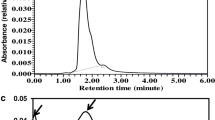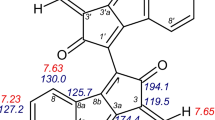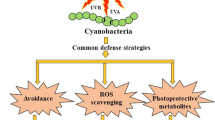Abstract
Cyanobacteria are the most promising group of photosynthetic microorganisms capable of producing an array of natural products of industrial importance. Scytonemin is a small hydrophobic alkaloid pigment molecules present in the extracellular sheath of several cyanobacteria as a protective mechanism against short wavelength solar ultraviolet (UV) radiation. It has great efficacy to minimize the production of reactive oxygen species and formation of DNA lesions. The biosynthesis of scytonemin is regulated by different physico-chemical stressors. Scytonemin display multiple roles, functioning as a potent UV sunscreen and antioxidant molecules, and can be exploited in cosmetic and other industries for the development of new cosmeceuticals. Herein, we review the occurrence, biosynthesis, and potential application of scytonemin in photoprotection, pharmaceuticals, and biomedical research.







Similar content being viewed by others
References
Rastogi, R. P., & Sinha, R. P. (2009). Biotechnological and industrial significance of cyanobacterial secondary metabolites. Biotechnology Advances, 27, 521–539.
Rastogi, R. P., Sinha, Richa, R. P., Singh, S. P., & Häder, D.-P. (2010). Photoprotective compounds from marine organisms. Journal of Industrial Microbiology and Biotechnology, 37, 537–558.
Manney, G. L., Santee, M. L., Rex, M., Livesey, N. J., Pitts, M. C., Veefkind, P., Nash, E. R., et al. (2011). Unprecedented Arctic ozone loss in 2011. Nature, 478, 469–475.
Williamson, C. E., Zepp, R. G., Lucas, R. M., Madronich, S., Austin, A. T., Ballaré, C. L., Norval, M., Sulzberger, B., Bais, A. F., McKenzie, R. L., Robinson, S. A., Häder, D.-P., Paul, N. D., & Bornman, J. F. (2014). Solar ultraviolet radiation in a changing climate. Nature Climate Change, 4, 434–441.
Rastogi, R. P., Sinha, R. P., Moh, S. H., Lee, T. K., Kottuparambil, S., Kim, Y.-J., Rhee, J.-S., Choi, E.-M., Brown, M. T., Häder, D.-P., & Han, T. (2014). Ultraviolet radiation and cyanobacteria. Journal of Photochemistry and Photobiology B: Biology, 141, 154–169.
Rastogi, R. P., Incharoensakdi, A., & Madamwar, D. (2014). Responses of a rice-field cyanobacterium Anabaena siamensis TISTR-8012 upon exposure to PAR and UV radiation. Journal of Plant Physiology, 171, 1545–1553.
Häder, D.-P., Williamson, C. E., Wängberg, S. A., Rautio, M., Rose, K. C., Gao, K., Helbling, E. W., Sinha, R. P., & Worrest, R. (2015). Effects of UV radiation on aquatic ecosystems and interactions with other environmental factors. Photochemical and Photobiological Sciences, 14, 108–126.
Rastogi, R.P., Richa, Kumar, A., Tyagi, M.B., & Sinha, R.P. (2010). Mechanisms of ultraviolet radiation-induced DNA damage and repair. Journal of Nucleic Acids, Article ID 592980, 32, doi:10.4061/2010/592980.
Rastogi, R. P., Madamwar, D., & Incharoensadki, A. (2015). Multiple defence mechanisms in cyanobacteria in response to solar UV radiation. In D. Davison (Ed.), Cyanobacteria: ecological importance, biotechnological uses and risk management (pp. 125–158). USA: NOVA.
Pothipongsa, A., Jantaro, S., & Incharoensakdi, A. (2012). Polyamines induced by osmotic stress protect Synechocystis sp. PCC 6803 cells and arginine decarboxylase transcripts against UV-B radiation. Applied Biochemistry and Biotechnology, 168, 1476–1488.
Jantaro, S., Baebprasert, W., Piyamawadee, C., Sodsuay, O., & Incharoensakdi, A. (2014). Exogenous spermidine alleviates UV-induced growth inhibition of Synechocystis sp. PCC 6803 via reduction of hydrogen peroxide and malonaldehyde levels. Applied Biochemistry and Biotechnology, 173, 1145–1156.
Dubey, G., & Prasad, S. M. (2015). Differential display of antioxidants in mitigating adverse effects of UV-B radiation in Nostoc muscorum and Phormidium foveolarum photoacclimated to different irradiances. Applied Biochemistry and Biotechnology, 175, 2703–2728.
Singh, S. P., Kumari, S., Rastogi, R. P., Singh, K. L., Richa, & Sinha, R. P. (2010). Photoprotective and biotechnological potentials of cyanobacterial sheath pigment, scytonemin. African Journal of Biotechnology, 9, 580–588.
Sinha, R. P., Rastogi, R. P., Ambasht, N. K., & Häder, D.-P. (2008). Life of wetland cyanobacteria under enhancing solar UV-B radiation. Proceedings of the National Academy of Sciences, India, Section B, 78, 53–65.
Rastogi, R. P., Kumari, S., Richa, Han, T., & Sinha, R. P. (2012). Molecular characterization of hot spring cyanobacteria and evaluation of their photoprotective compounds. Canadian Journal of Microbiology, 58, 719–727.
Rastogi, R. P., Sinha, R. P., & Incharoensakdi, A. (2013). Partial characterization, UV-induction and photoprotective function of sunscreen pigment, scytonemin from Rivularia sp. HKAR-4. Chemosphere, 93, 1874–1878.
Rastogi, R. P., & Incharoensakdi, A. (2013). UV radiation-induced accumulation of photoprotective compounds in the green alga Tetraspora sp. CU2551. Plant Physiology and Biochemistry, 70, 7–13.
Rastogi, R. P., & Incharoensakdi, A. (2014). Analysis of UV-absorbing photoprotectant mycosporine-like amino acid (MAA) in the cyanobacterium Arthrospira sp. CU2556. Photochemical and Photobiological Sciences, 13, 1016–1024.
Rastogi, R. P., & Incharoensakdi, A. (2015). Occurrence and induction of a ultraviolet-absorbing substance in the cyanobacterium Fischerella muscicola TISTR8215. Phycological Research, 63, 51–55.
Mushir, M., & Fatma, T. (2012). Monitoring stress responses in cyanobacterial scytonemin—screening and characterization. Environmental Technology, 33, 153–157.
Garcia-Pichel, F., & Castenholz, R. W. (1991). Characterization and biological implications of scytonemin, a cyanobacterial sheath pigment. Journal of Phycology, 27, 395–409.
Dillon, J. G., & Castenholz, R. W. (1999). Scytonemin, a cyanobacterial sheath pigment, protects against UVC radiation: implications for early photosynthetic life. Journal of Phycology, 35, 673–681.
Javor, B., & Castenholz, R. W. (1984). Productivity studies of microbial mats, Laguna Guerrero Negro, Mexico. In Y. Cohen, R. W. Castenholz, & H. Halvorsan (Eds.), Microbial mats: stromatolites (pp. 149–170). New York: Alan Liss, Inc.
Fleming, E. D., & Castenholz, R. W. (2007). Effects of periodic desiccation on the synthesis of the UV-screening compound, scytonemin, in cyanobacteria. Environmental Microbiology, 9, 1448–1455.
Sinha, R. P., Klisch, M., Vaishampayan, A., & Häder, D.-P. (1999). Biochemical and spectroscopic characterization of the cyanobacterium Lyngbya sp. inhabiting mango (Mangifera indica) trees: presence of an ultraviolet-absorbing pigment, scytonemin. Acta Protozoologica, 38, 291–298.
Richter, P. R., Sinha, R. P., & Häder, D.-P. (2006). Scytonemin-rich epilithic cyanobacteria survive acetone treatment. Current Trends in Microbiology, 2, 13–19.
Rastogi, R. P., & Incharoensakdi, A. (2014). Characterization of UV-screening compounds, mycosporine-like amino acids, and scytonemin in the cyanobacterium Lyngbya sp. CU2555. FEMS Microbiology Ecology, 87, 244–256.
Muehlstein, L., & Castenholz, R. W. (1983). Sheath pigment formation in a blue green alga, Lyngbya aestuari, as an adaptation to high light. Biology Bulletin, 165, 521–522.
Rath, J., Mandal, S., & Adhikary, S. P. (2012). Salinity induced synthesis of UV-screening compound scytonemin in the cyanobacterium Lyngbya aestuarii. Journal of Photochemistry and Photobiology, B: Biology, 115, 5–8.
Balskus, E. P., Case, R. J., & Walsh, C. T. (2011). The biosynthesis of cyanobacterial sunscreen scytonemin in intertidal microbial mat communities. FEMS Microbiology Ecology, 77, 322–332.
Dodds, W. K. (1989). Photosynthesis of two morphologies of Nostoc parmelioides as related to current velocities and diffusion patterns. Journal of Phycology, 25, 258–262.
Matsui, K., Nazifi, E., Hirai, Y., Wada, N., Matsugo, S., & Sakamoto, T. (2012). The cyanobacterial UV-absorbing pigment scytonemin displays radical scavenging activity. Journal of General and Applied Microbiology, 58, 137–144.
Itoh, T., Koketsu, M., Yokota, N., Touho, S., Ando, M., & Tsukamasa, Y. (2014). Reduced scytonemin isolated from Nostoc commune suppresses LPS/IFNγ-induced NO production in murine macrophage RAW264 cells by inducing hemeoxygenase-1 expression via the Nrf2/ARE pathway. Food and Chemical Toxicology, 69, 330–338.
Chen, J., Zhao, L., Xu, J., Yang, R., He, S., & Yan, X. (2013). Determination of oxidized scytonemin in Nostoc commune Vauch cultured on different conditions by high performance liquid chromatography coupled with triple quadrupole mass spectrometry. Journal of Applied Phycology, 25, 1001–1007.
Ehling-Schulz, M., Bilger, W., & Scherer, S. (1997). UV-B-induced synthesis of photoprotective pigments and extracellular polysaccharides in the terrestrial cyanobacterium Nostoc commune. Journal of Bacteriology, 179, 1940–1945.
Dodds, W. K., & Castenholz, R. W. (1988). The nitrogen budget of an oligotrophic cold water pond. Archiv für Hydrobiologie, Supplement, 79, 343–362.
Soule, T., Palmer, K., Gao, Q., Potrafka, R. M., Stout, V., & Garcia-Pichel, F. (2009). A comparative genomics approach to understanding the biosynthesis of the sunscreen scytonemin in cyanobacteria. BMC Genomics, 10, 336.
Soule, T., Stout, V., Swingley, W. D., Meeks, J. C., & Garcia-Pichel, F. (2007). Molecular genetics and genomic analysis of scytonemin biosynthesis in Nostoc punctiforme ATCC 29133. Journal of Bacteriology, 189, 4465–4472.
Proteau, P. J., Gerwick, W. H., Garcia-Pichel, F., & Castenholz, R. (1993). The structure of scytonemin, an ultraviolet sunscreen pigment from the sheaths of cyanobacteria. Experientia, 49, 825–829.
Asencio, A. D., & Hoffmann, L. (2013). Chemosystematic evaluation of the genus Scytonema (Cyanobacteria) based on occurrence of phycobiliproteins, scytonemin, carotenoids and mycosporine-like amino acid compounds. European Journal of Phycology, 48, 331–344.
Bultel-Poncѐ, V., Felix-Theodose, F., Sarthou, C., Ponge, J.-F., & Bodo, B. (2004). New pigments from the terrestrial cyanobacterium Scytonema sp. collected on the Mitaraka Inselberg, French Guyana. Journal of Natural Products, 67, 678–681.
Rastogi, R. P., Sonani, R. R., & Madamwar, D. (2014). The high-energy radiation protectant extracellular sheath pigment scytonemin and its reduced counterpart in the cyanobacterium Scytonema sp. R77DM. Bioresource Technology, 171, 396–400.
Grant, C. S., & Louda, J. W. (2013). Scytonemin-imine, a mahogany-colored UV/Vis sunscreen of cyanobacteria exposed to intense solar radiation. Organic Geochemistry, 65, 29–36.
Castenholz, R. W. (1984). Hot-spring microbial mats. A summary. In Y. Cohen, R. W. Castenholz, & H. Halvorsan (Eds.), Microbial mats: stromatolites (pp. 101–119). New York: Alan Liss, Inc.
Garcia-Pichel, F., Sherry, N. D., & Castenholz, R. W. (1992). Evidence for an ultraviolet sunscreen role of the extracellular pigment scytonemin in the terrestrial cyanobacterium Chlorogloeopsis sp. Photochemistry and Photobiology, 56, 17–23.
Squier, A. H., Hodgson, D. A., & Keely, B. J. (2004). A critical assessment of the analysis and distributions of scytonemin and related UV screening pigments in sediments. Organic Geochemistry, 35, 1221–1228.
Jehlička, J., Edwards, H. G. M., & Oren, A. (2014). Raman spectroscopy of microbial pigments. Applied and Environmental Microbiology, 80, 3286–3295.
Varnali, T., & Edwards, H.G.M. (2014). Raman spectroscopic fingerprints of scytonemin-imine: density functional theory calculations of a novel potential biomarker. Philosophical Transactions of the Royal Society A 372. doi:10.1098/rsta.2014.0201.
Balskus, E. P., & Walsh, C. T. (2008). Investigating the initial steps in the biosynthesis of cyanobacterial sunscreen scytonemin. Journal of the American Chemical Society, 130, 15260–15261.
Balskus, E. P., & Walsh, C. T. (2009). An enzymatic cyclopentyl[b]indole formation involved in scytonemin biosynthesis. Journal of the American Chemical Society, 131, 14648–14649.
Sorrels, C. M., Proteau, P. J., & Gerwick, W. H. (2009). Organization, evolution, and expression analysis of the biosynthetic gene cluster for scytonemin, a cyanobacterial UV absorbing pigment. Applied and Environmental Microbiology, 75, 4861–4869.
Malla, S., & Sommer, M. O. A. (2014). A sustainable route to produce the scytonemin precursor using Escherichia coli. Green Chemistry, 16, 3255–3265.
Dillon, J. G., Tatsumi, C. M., Tandingan, P. G., & Castenholz, R. W. (2002). Effect of environmental factors on the synthesis of scytonemin, a UV-screening pigment, in a cyanobacterium (Chroococcidiopsis sp.). Archives of Microbiology, 177, 322–331.
Fleming, E. D., & Castenholz, R. W. (2008). Effects of nitrogen source on the synthesis of the UV screening compound, scytonemin, in the cyanobacterium Nostoc punctiforme PCC 73102. FEMS Microbiology Ecology, 63, 301–308.
Garcia-Pichel, F., & Castenholz, R. W. (1993). Occurrence of UV-absorbing, mycosporine-like compounds among cyanobacterial isolates and an estimate of their screening capacity. Applied and Environmental Microbiology, 59, 163–169.
Gao, Q., & Garcia-Pichel, F. (2011). Microbial ultraviolet sunscreens. Nature Reviews Microbiology, 9, 791–802.
Takamatsu, S., Hodges, T. W., Rajbhandari, I., Gerwick, W. H., Hamann, M. T., & Nagle, D. G. (2003). Marine natural products as novel antioxidant prototypes. Journal of Natural Products, 66, 605–608.
McInnes, C., Mezna, M., & Fischer, P. M. (2005). Progress in the discovery of polo-like kinase inhibitors. Current Topics in Medicinal Chemistry, 5, 181–197.
Stevenson, C. S., Capper, E. A., Roshak, A. K., Marquez, B., Eichman, C., Jackson, J. R., Mattern, M., Gerwick, W. H., Jacobs, R. S., & Marshall, L. A. (2002). The identification and characterization of the marine natural product scytonemin as a novel antiproliferative pharmacophore. Journal of Pharmacology and Experimental Therapeutics, 303, 858–866.
Stevenson, C. S., Capper, E. A., Roshak, A. K., Marquez, B., Grace, K., Gerwick, W. G., Jacobs, R. S., & Marshall, L. A. (2002). Scytonemin, a marine natural product inhibitor of kinases key in hyperproliferative inflammatory diseases. Inflammation Research, 51, 112–114.
Strebhardt, K., & Ullrich, A. (2006). Targeting polo-like kinase 1 for cancer therapy. Nature Reviews Cancer, 6, 321–330.
Barr, F. A., Silljé, H. H., & Nigg, E. A. (2004). Polo-like kinases and the orchestration of cell division. Nature Reviews Molecular Cell Biology, 5, 429–440.
Zhang, G., Zhang, Z., & Liu, Z. (2013). Polo-like kinase 1 is overexpressed in renal cancer and participates in the proliferation and invasion of renal cancer cells. Tumor Biology, 34, 1887–1894.
Zhang, G., Zhang, Z., & Liu, Z. (2013). Scytonemin inhibits cell proliferation and arrests cell cycle through downregulating Plk1 activity in multiple myeloma cells. Tumour Biology, 34, 2241–2247.
Ito, Y., Yoshida, H., Matsuzuka, F., Matsuura, N., Nakamura, Y., Nakamine, H., Kakudo, K., Kuma, K., & Miyauchi, A. (2004). Polo-like kinase 1 (PLK1) expression is associated with cell proliferative activity and Cdc2 expression in malignant lymphoma of the thyroid. Anticancer Research, 24, 259–264.
Acknowledgments
Rajesh P Rastogi is thankful to the University Grant Commission (UGC), New Delhi, India, for Dr. D. S. Kothari Post-Doctoral Research Grant. Ravi R. Sonani thanks DST, New Delhi, for INSPIRE fellowship.
Compliance with Ethical Standards
The authors declare that there is no any ethical issue.
Conflict of Interest
The authors declare that they have no conflict of interest.
Author information
Authors and Affiliations
Corresponding authors
Rights and permissions
About this article
Cite this article
Rastogi, R.P., Sonani, R.R. & Madamwar, D. Cyanobacterial Sunscreen Scytonemin: Role in Photoprotection and Biomedical Research. Appl Biochem Biotechnol 176, 1551–1563 (2015). https://doi.org/10.1007/s12010-015-1676-1
Received:
Accepted:
Published:
Issue Date:
DOI: https://doi.org/10.1007/s12010-015-1676-1




